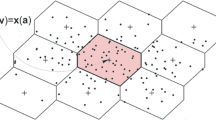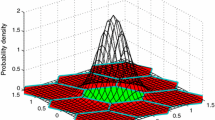Abstract
Accurate and reliable carrier phase ambiguity resolution (AR) is the key to global navigation satellite system (GNSS) high-precision navigation and positioning applications. The integer least squares (ILS) estimation and the best integer equivariant (BIE) estimation are two widely used AR method, with the former considered to have the highest success rate and the latter to be optimal in the minimum mean squared error (MSE) sense. We analyzed three key issues of applying the BIE method in detail, including the use boundary of BIE, the number of candidates to be involved, and the weight determination among ambiguity candidates. It has been demonstrated that the BIE estimator is superior to ILS estimator from an overall perspective, but not always the best in each specific epoch. Therefore, we recommend constructing an integrated ambiguity resolution scheme that combines BIE with ILS, and we propose to adopt the optimal integer aperture (OIA) test as a criterion to distinguish the two. Moreover, a new criterion referred to the OIA test is proposed to determine the number of candidates involved in the BIE estimator. We also attempt to add the quadratic forms of baseline residuals into the weight function of BIE, aiming to reach a more accurate estimator. Finally, an integrated AR method that combines ILS with BIE and distinguished by the OIA test is proposed, named OIA-BIE. A set of real-measured vehicle data are tested to evaluate its performance, compared to least squares (LS), ILS, and the original BIE. The results show that the positioning accuracy of OIA-BIE is a little better than BIE, better than ILS, and significantly better than LS. Moreover, the average time consumption of ILS, BIE, and OIA-BIE are also evaluated, with 1.15, 14.62, and 3.71 ms, respectively, and OIA-BIE is four times more efficient than BIE.




















Similar content being viewed by others
Data availability
The data used in this manuscript are available from the corresponding author upon request.
References
Chang XW, Yang X, Zhou T (2005) MLAMBDA: a modified LAMBDA method for integer least-squares estimation. J Geod 79(9):552–565
Duong V, Harima K, Choy S et al (2021) GNSS best integer equivariant estimation using multivariant t-distribution: a case study for precise point positioning. J Geod 95(1):1–17
Euler HJ, Schaffrin B (1991) On a measure for the discernibility between different ambiguity solutions in the static-kinematic GPS-mode. Kinemat Syst Geod Survey Remote Sens 107:285–295
Fincke U, Pohst M (1985) Improved methods for calculating vectors of short length in a lattice, including a complexity analysis. Math Comput 44:463–471
Han S (1997) Quality control issues relating to instantaneous ambiguity resolution for real-time GPS kinematic positioning. J Geod 71(6):351–361
De Jonge PJ, Tiberius CCJM (1996) The LAMBDA method for integer ambiguity estimation: implementation aspects. LGR-Series, technical report, Delft University of Technology
Li X, Ge M, Dai X, Ren X, Mathias F, Jens W, Harald H (2015) Accuracy and reliability of multi-GNSS real-time precise positioning: GPS, GLONASS, BeiDou, and Galileo. J Geod 89(6):607–635
Odolinski R, Teunissen PJG (2020) Best integer equivariant estimation: performance analysis using real data collected by low-cost, single- and dual-frequency, multi-GNSS receivers for short- to long-baseline RTK positioning. J Geod 94(9):1–17
Odolinski R, Teunissen P, Odijk D (2015) Combined BDS, Galileo, QZSS and GPS single-frequency RTK. GPS Solut 19(1):151–163
Odolinski R, Teunissen PJG (2022) Best integer equivariant position estimation for multi-GNSS RTK: a multivariate normal and t-distributed performance comparison. J Geod 96:3. https://doi.org/10.1007/s00190-021-01591-9
Teunissen PJG (1995) The least-squares ambiguity decorrelation adjustment: A method for fast GPS integer ambiguity estimation. J Geod 70(1–2):65–82
Teunissen PJG (2003a) Integer aperture GNSS ambiguity resolution. Artif Satell 38(3):79–88
Teunissen PJG (2003b) Theory of integer equivariant estimation with application to GNSS. J Geod 77(7–8):402–410
Teunissen PJG (2004) Penalized GNSS Ambiguity Resolution. J Geod 78(4–5):235–244
Teunissen PJG (2005a) GNSS ambiguity resolution with optimally controlled failure-rate. Artif Satell 40(4):219–227
Teunissen PJG (2005b) A carrier phase ambiguity estimator with easy to evaluate fail-rate. Artif Satell 38(3):89–96
Teunissen PJG (2005c) On the computation of the best integer equivariant estimator. Artif Satell 40(3):161–171
Teunissen PJG, Verhagen S (2011) Integer aperture estimation a framework for GNSS ambiguity acceptance testing. Inside GNSS 2011:66–73
Teunissen PJG, Verhagen S (2009) GNSS carrier phase ambiguity resolution: challenges and open problems. In: Sideris MG (eds) Observing our changing earth. Int Assoc Geodesy Symp vol 133. https://doi.org/10.1007/978-3-540-85426-5_90, Springer, Berlin, Heidelberg
Teunissen PJG (1993) Least-squares estimation of the integer GPS ambiguities. Invited lecture, Section IV Theory and Methodology, IAG General Meeting, Beijing, China, p 16 (also in: LGR series No6, Delft Geodetic Computing Center, Delft University of Technology)
Teunissen PJG (2020) Best integer equivariant estimation for elliptically contoured distributions. J Geod 94:82. https://doi.org/10.1007/s00190-020-01407-2
Tiberius C, Jonge P (1995) Fast positioning using the LAMBDA method. In: Proceedings DSNS-95, paper, 30(8)
Verhagen S, Teunissen PJG (2005) Performance comparison of the BIE Estimator with the float and fixed GNSS ambiguity estimators. In: A window on the future of geodesy, international association of geodesy symposia, vol 128. Springer, Berlin, pp 428–433
Verhagen S, Teunissen PJG (2006) New global navigation satellite system ambiguity resolution method compared to existing approaches. J Guid Cont Dyn 29(4):981–991
Verhagen S, Teunissen PJG (2013) The ratio test for future GNSS ambiguity resolution. GPS Solut 17:535–548. https://doi.org/10.1007/s10291-012-0299-z
Verhagen S (2005) The GNSS integer ambiguities: estimation and validation. PhD dissertation, Netherlands Geodetic Commission, Publications on Geodesy, 58
Vollath U, Talbot NC (2013) GNSS signal processing methods and apparatus with candidate set selection. US Patent 008368590B2, 5 February
Wang L, Verhagen S (2015) A new ambiguity acceptance test threshold determination method with controllable failure rate. J Geod 89(4):361–375
Wang J, Stewart M, Tsakiri M (1998) A discrimination test procedure for ambiguity resolution on-the-fly. J Geod 72(11):644–653
Wen Z, Henkel P, Back A et al (2012) Best integer equivariant estimation for precise point positioning. In: ELMAR2012
Wu Z, Bian S (2015) GNSS integer ambiguity validation based on posterior probability. J Geod 89(10):961–977
Xu P L, Cannon E, Lachapelle G (1995) Mixed integer programming for the resolution of GPS carrier phase ambiguities. In IUGG95 Assembly, Boulder, July 2–14. arXiv preprint https://arxiv.org/1010.1052
Zhang J, Wu M, Li T, Zhang K (2015) Integer aperture ambiguity resolution based on difference test. J Geod 89(7):667–683
Zhou F, Yang YZ, Wang L, Xu TH (2022) GNSS carrier phase integer equivariant estimator and its application in improving PPP performance. Acta Geod Cartogr Sin. https://kns.cnki.net/kcms/detail/11.2089.P.20220105.2043.002.html.
Acknowledgements
This study was supported by the National Key R&D Program of China (Grant No. 2021YFC3000501), the National Natural Science Foundation of China (Grant Nos. 41961144015, 41804020), the China Postdoctoral Science Foundation (Grant No. 2020M682484), the Wuhan Science and Technology Project (Grant No. 2020010601012185).
Author information
Authors and Affiliations
Corresponding author
Additional information
Publisher's Note
Springer Nature remains neutral with regard to jurisdictional claims in published maps and institutional affiliations.
Rights and permissions
About this article
Cite this article
Ma, L., Lou, Y., Lu, L. et al. GNSS best integer equivariant estimation combining with integer least squares estimation: an integrated ambiguity resolution method with optimal integer aperture test. GPS Solut 26, 100 (2022). https://doi.org/10.1007/s10291-022-01285-5
Received:
Accepted:
Published:
DOI: https://doi.org/10.1007/s10291-022-01285-5




